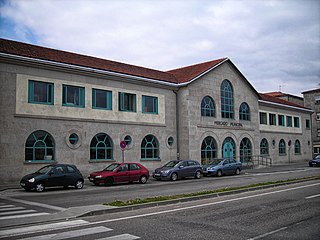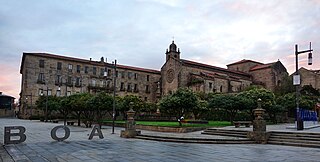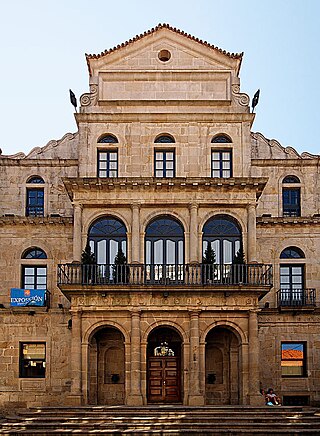
The church of the Pilgrim Virgin is a scallop-shaped Roman Catholic chapel located in the city of Pontevedra, in Spain, along the route of the Portuguese Way of St. James.

The Church of Saint Bartholomew is a Catholic religious building in the city of Pontevedra, Galicia, Spain. The church was built in the late 17th century in the Baroque style as a place of worship and pastoral activities for the adjoining Jesuit college. The church was dedicated to Saint Bartholomew when it became a parish church in 1836.

The Fonseca House is a building on the Paseo de Colón in the city of Pontevedra, Spain. It is one of the most impressive historical buildings in the city, distinguished by its neoclassical architecture and by the two stone Sphinxes and two large Canary palm trees that flank its entrance. It is currently the headquarters of the Historical Archive of the Province of Pontevedra.

The building of the former Pontevedra Normal School of Pontevedra, in Pontevedra, Spain, is an eclectic building from the end of the 19th century that was the headquarters of the teacher training college of this Galician city. It is located on the Gran Vía de Montero Ríos, between the Alameda de Pontevedra and the Palm Trees Park.

The Plaza de Teucro is a square of medieval origin located in the heart of the old town of Pontevedra (Spain). It is the most harmoniously proportioned medieval square in the city.

The Central Market of Pontevedra is a covered market located in Pontevedra, Spain. It is located at the north-eastern edge of the historic centre, close to the Burgo Bridge. It overlooks the banks of the Lérez river and was inaugurated in 1948.

The Plaza de la Pedreira or Plaza de Mugartegui is a square of medieval origin located in the northern part of the old town of Pontevedra (Spain).

The Convent of St. Francis is a Franciscan convent located in the city centre of Pontevedra (Spain), overlooking the Plaza de la Herrería. The Gothic church of San Francis is attached to the convent on the southeast side.

The Liceo Casino is a neoclassical building from 1878 located in the historic centre of Pontevedra, which houses the oldest cultural and leisure society in Pontevedra, Spain.

Curros Enríquez Square is a square of medieval origin located in the heart of the historic centre of Pontevedra (Spain), on the Portuguese pilgrimage way.

The Sanctuary of the Apparitions is a Catholic convent and sanctuary located in Pontevedra, Spain. According to Sister Lúcia, it was here that the child Jesus and the Virgin Mary appeared to her in 1925-1926 and revealed to her the First Saturdays Devotion.

The Chapel of the Nazarene is a Catholic religious building, with the status of chapel, located in the old town of Pontevedra (Spain), in Duque de Tetuán Street, opposite the Principal Theatre.

St. Joseph's Square is a 19th century square located in the centre of the city of Pontevedra (Spain), in the first urban expansion area, near the Campolongo neighbourhood.

The former Saint Ferdinand Barracks in Pontevedra, is a large neoclassical building from the beginning of the 20th century located in the centre of Pontevedra (Spain), opposite the Doctor Marescot Gardens and very close to the Alameda de Pontevedra.

A Moureira is the old seafarers' and fishermen's quarter of the city of Pontevedra (Spain), where the Seamen's Guild lived, near the Lérez river, the Pontevedra ria and the Gafos river. Nowadays, it is part of the city centre.

The Plaza del Muelle or Praza do Peirao is a square of medieval origin located at the northern edge of the historic centre of Pontevedra (Spain), very close to the Burgo Bridge and the old port neighbourhood A Moureira.

The Chapel of the Holy Souls in Purgatory is a small neo-Gothic Catholic religious building located in the old town of Pontevedra (Spain), in Ánimas Street, near Curros Enríquez Square.

Alonso de Fonseca Square is a medieval square located in the historic centre of the city of Pontevedra (Spain), opposite the Basilica of Saint Mary Major.

Calle Real is a street in the Spanish city of Pontevedra, located in the city's historic centre.

Calle Sarmiento is a street in the Spanish city of Pontevedra, located in the city's historic centre.



























